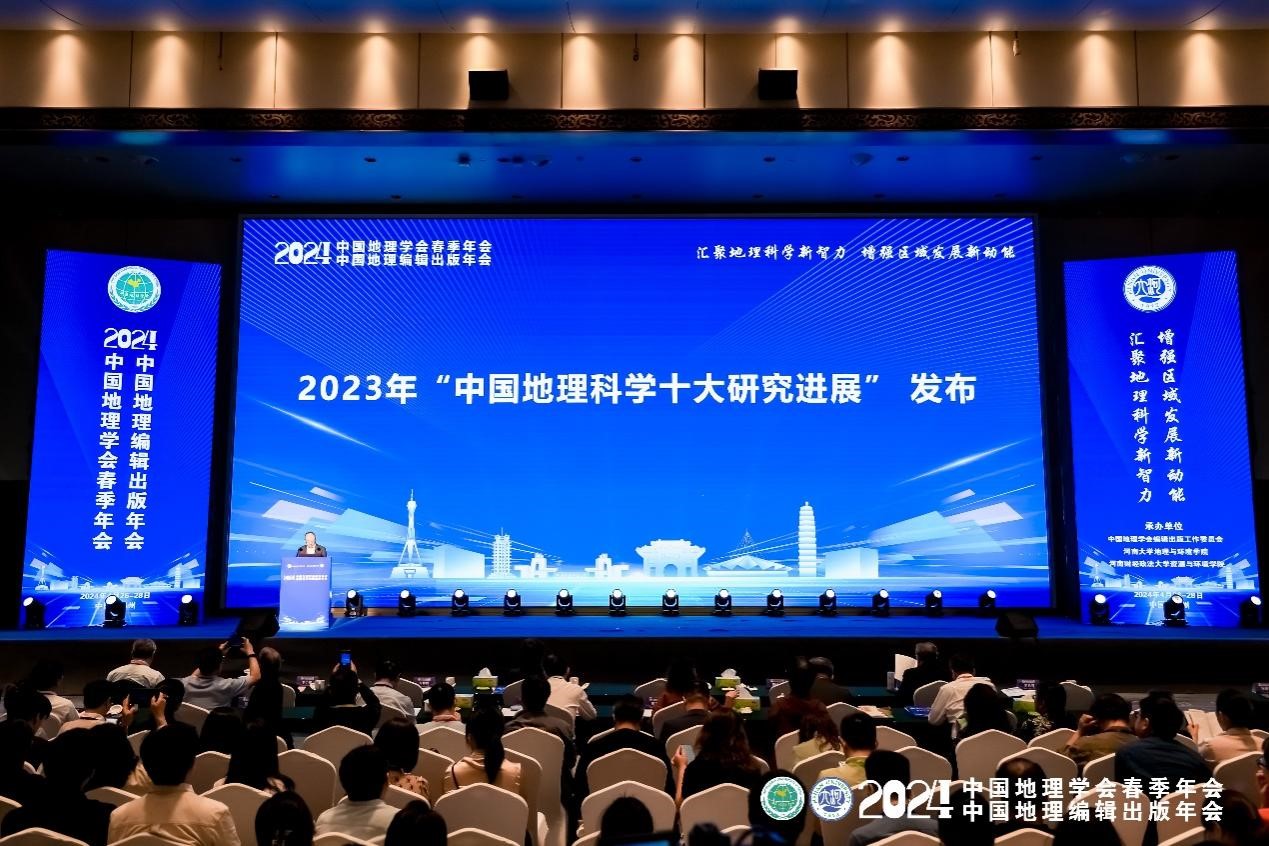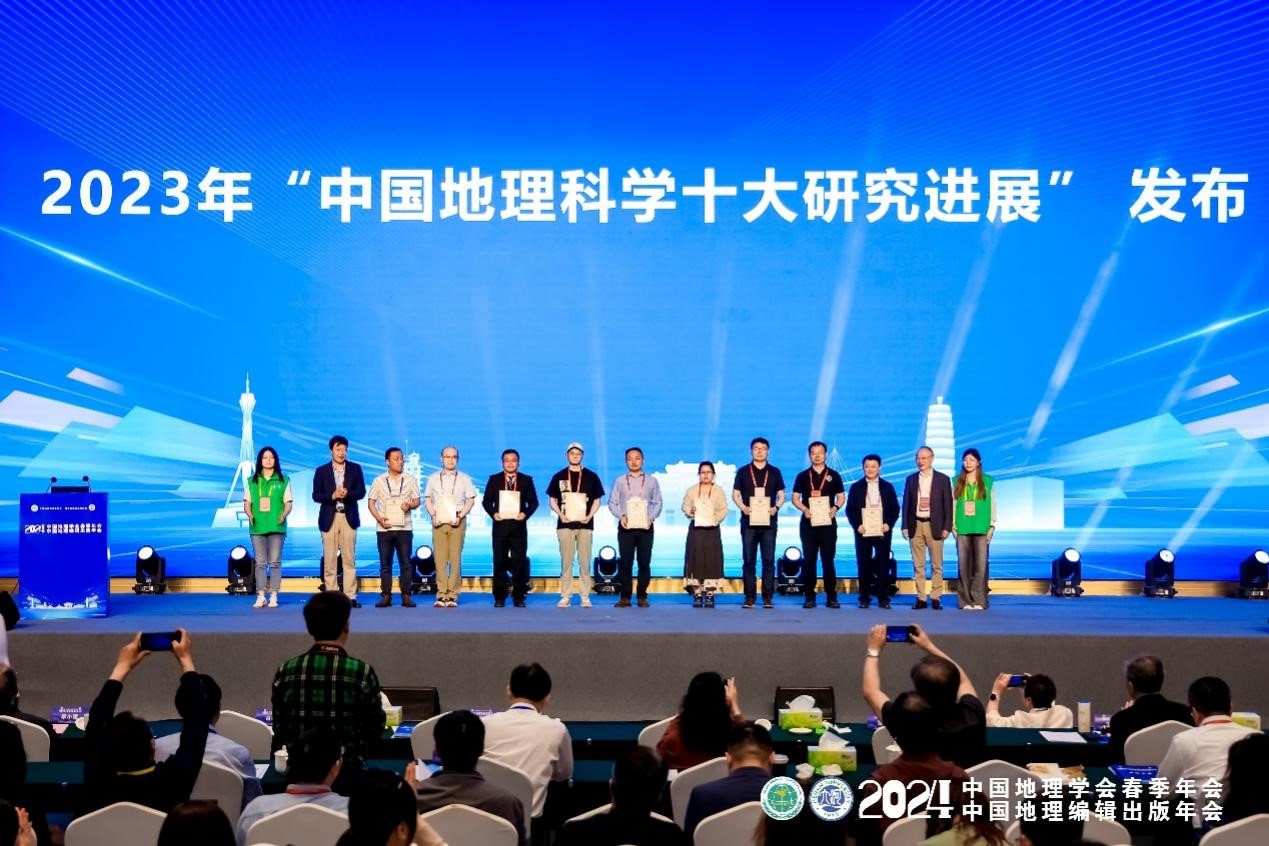The 2024 Spring Annual Meeting of the Chinese Geographical Society, as well as the Chinese Geography Editorial and Publishing Annual Meeting, was held from April 26 to 28 in Zhengzhou, Henan. On the morning of April 27, the Chinese Geographical Society announced the results of the "Top 10 Research Advances in Chinese Geography" for 2023. The research project "Processes and Mechanisms of Prehistoric East-West Exchanges and the Evolution of Human-Land Relations in Inner Asian Mountain Corridors," jointly submitted by Professor Dong Guanghui's group and Professor Huang Xiaozhong's group from our Institute's Environmental Archaeology Team, was awarded this honor.

Fig.1 Announcement of the "Top 10 Research Advances in Chinese Geography" for 2023 (Source: Official Website of the Conference)
To fully implement the spirit of the 20th National Congress of the Chinese Communist Party, address national strategic needs and long-term development, strengthen the national strategic scientific and technological forces, accelerate major national science and technology projects, enhance basic research, focus on scientific and technological self-reliance, win the battle of key core technologies, and promote the development of Chinese geographical science, the Chinese Geographical Society launched the selection process for the 2023 "Top 10 Research Advances in Chinese Geography" in January 2024, in accordance with the "Top 10 Research Advances in Chinese Geography" Selection Implementation Measures. After the recommendation of the Fellows and Executive Directors of the Geographical Society of China and the branches of the Society, the formal review, the preliminary and final evaluation by the selection panel, 10 achievements were selected as the Top 10 Research Progresses in Chinese Geosciences in 2023, including the study of " Processes and Mechanisms of Prehistoric East-West Exchanges and the Evolution of Human-Land Relations in Inner Asian Mountain Corridors ".

Fig.2 President Chen Fahu and Vice President Professor Song Changqing of the Chinese Geographical Society presenting the honorary certificates to the representatives of the awarded achievements (Source: Official Website of the Conference)
Between 6000 and 3000 years ago, the long-distance cross-regional exchanges in Eurasia not only bridged the two major civilization systems of the East and the West for the first time, reshaping the geographical pattern of the world's early civilization, but also laid the foundation for the distribution of present-day ethnic groups and cultures. The Inner Asian mountain corridor, including the Tianshan Mountains and Altay Mountains, was an important channel for early East-West exchanges, and the process and dynamics of the prehistoric human-earth relationship in this region have received extensive attention from scholars at home and abroad. Most of the existing studies focus on the spatial and temporal processes of prehistoric transcontinental exchanges and agricultural dissemination, and the driving factors and mechanisms behind them are still unclear. In response to the above problems, the environmental archaeology team of Lanzhou University, in cooperation with domestic and foreign institutions and scholars, has carried out a systematic study of the Inner Asian mountainous corridor, and achieved a series of results: 1) It is found that the northern part of the corridor centered on the Altai Mountains had a warm climate from 6500 to 3600 years ago, and the increase in the regional productivity, especially in the period of 4800-4300 years ago, created the conditions for the East and West to move to the steppe area, and facilitated the prehistoric transcontinental exchanges and agricultural spread; 2) The degradation of vegetation caused by the cooling event in the region about 3600 years ago stimulated the urgent need for new energy sources, and bituminous coal became a new fuel choice for the ancestors at the Jirentai Goukou site in the central Tianshan Mountains after the fuelwood was used, which advanced the realization of the earliest systematic exploitation of coal resources by mankind by at least one thousand years; 3) The research constructs a conceptual model to explain the evolution of ancient land relations, suggesting that regional-scale technological and social innovations contributed to rapid population growth and the widespread diffusion of people and technologies, and that the fit between continental-scale resources and social patterns profoundly influenced cultural and geographical patterns. The research also points out that the development of Bronze Culture in the Inner Asian mountain corridors benefited from the richness of pastures and oasis resources, as well as a high degree of fit between newly introduced agriculture and animal husbandry.

Figure.3 Visualization of the research results (Cartography: Xiang Lixiong)
The study is based on, but not limited to, the Inner Asian Mountain Corridor region. The research team focused on the universal adaptive behaviors of human beings in the context of climate and environmental change, as well as the interaction patterns of various natural and human factors across different spatial scales within the context of a grand era. This provides key scientific evidence and new theoretical interpretations for a deeper understanding of the processes and mechanisms of the evolution of human-earth relations in the context of early transcontinental exchanges. The related findings were published in 2023 in international high-level journals such as Science Advances, Nature Communications, and The Innovation Geoscience, attracting widespread attention from scholars, media, and the public at home and abroad, contributing to the development of geography and related disciplines. The main contributors are Professor Dong Guanghui, Doctoral Student Qiu Menghan, Doctor Xiang Lixiong, Doctoral Student Du Linyao, and Professor Huang Xiaozhong.
Official selection results push:
https://mp.weixin.qq.com/s/WiVwnpFYwiOXGTFAJbL4tw.
Related research results DOI: 10.1126/sciadv.adh0549; 10.1038/s41467-023-38828-4; 10.59717/j.xinn-geo.2023.100038.